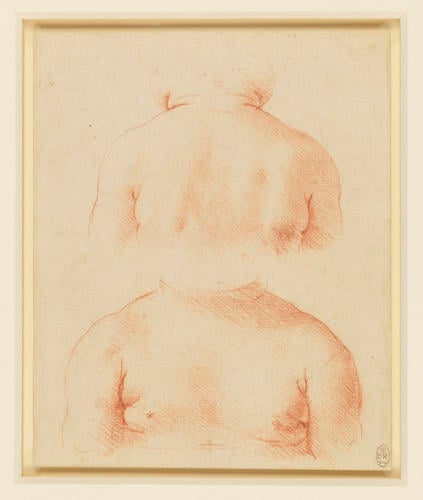-
1 of 253523 objects
The bust of a child from front and back c.1500
Red chalk | 16.5 x 13.6 cm (sheet of paper) | RCIN 912567

Leonardo da Vinci (1452-1519)
The bust of a child from front and back c.1500

Leonardo da Vinci (1452-1519)
The bust of a child from front and back c.1500


-
Two studies of the bust of a child, the head barely indicated, from back and from front.
The drawing must be related to another at Windsor, of the bust of a child in left profile (RCIN 912519), for the chest of the child terminates at the same horizontal line in all three studies. The obvious context for the two drawings would be a terracotta bust of the Christ Child or Infant Baptist, common during the Renaissance as suitable exemplars in children’s nurseries. While no such bust by Leonardo is known – indeed, no surviving sculpture is universally accepted as being by the artist – the Milanese artist and writer Gian Paolo Lomazzo described in 1584 a terracotta bust of the Christ Child supposedly by Leonardo, in his own collection. It is impossible to generalise about the drawing habits of Renaissance sculptors, other than that they seem to have drawn little, presumably preferring to 'sketch' their ideas as small models in clay or wax; but sculptors who were also painters, such as Leonardo, may well have prepared their three-dimensional pieces in a different manner from those who practised sculpture alone. Leonardo had also been involved in architectural projects, with the emphasis on plan and elevation, and he had measured man and horse from orthogonal viewpoints around 1490. Within continuous space Leonardo would have had a heightened awareness of the geometrical convention of orthogonals, and this must have affected the way in which he perceived (and conceived) solid form.
The rather insecure outlines and dry hatching are typical of Leonardo's earlier drawings in red chalk, and the careful handling of the chalk here suggests a date around 1500, or possibly earlier. The putative terracotta could thus have been executed either during Leonardo’s last years in Sforza Milan – perhaps for the nursery of Ludovico’s sons Massimiliano (b. 1493) and Francesco (b. 1495) – or soon after his return to Florence.
Leonardo's first outline for a treatise on anatomy, drafted around 1490, included a note to study 'which are the members which, after the child is born, grow more than the others, and the measurements of a child of one year.' There is however no indication in Leonardo's surviving proportional drawings that he attempted to codify the dimensions of the child; the variable growth rates of the different parts, and from child to child, would have rendered this impractical. This drawing seems to be simply a visual survey of the soft contours of a thriving infant, with no attempt to analyse its proportions.
C. Bambach (Leonardo da Vinci Rediscovered, 2019, I, p. 91; IV, p.113, n. 58) suggests that the drawing is a 'replacement copy' by Francesco Melzi (of the type of 912492, 912361, 912549 etc). The outlines of the present drawing are however much more tentative and exploratory than those hard copies.Provenance
Bequeathed to Francesco Melzi; from whose heirs purchased by Pompeo Leoni, c.1582-90; Thomas Howard, 14th Earl of Arundel, by 1630; probably acquired by Charles II; Royal Collection by 1690
-
Creator(s)
Acquirer(s)
-
Medium and techniques
Red chalk
Measurements
16.5 x 13.6 cm (sheet of paper)
Other number(s)
RL 12567Alternative title(s)
A bust of a child from the front and back